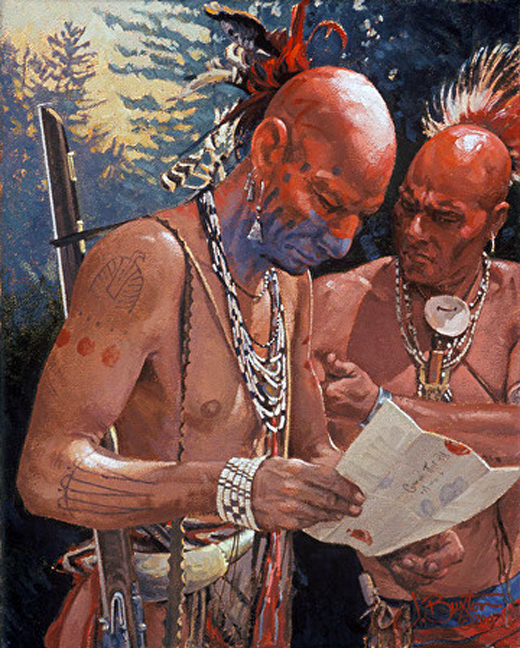Website review: The 18th Century Material Culture Resource Center (also on Facebook)
Debunking myths is one of our favorite things at Journal of the American Revolution: setting the story straight on things that have become shrouded in exaggeration or falsehood. We seldom, however, deal with topics concerning material culture, the everyday objects and articles that surrounded the people and events about which we publish. The material culture of the era is as muddled with myth as many of the events. Television shows, reenactments, antique shops, auction sites are all littered with things that look “old” and fit a general perception of “colonial times,” but which don’t, in fact, date from the era of the American Revolution. Fortunately, there is a place to go for information things that made up the substance life in the Revolutionary era.
The 18th Century Material Culture Resource Center is a website devoted to illustrating things that are known with certainty to date from the Georgian era. Using a combination of photographs of objects with known provenance, and pictures rendered during the time period, the Resource Center allows viewers to see the stylistic elements that defined the material culture of the day. Wondering whether those cute octagonal eyeglasses that you found in an antique shop date from the 1770s? You can find out if that style shows up in any period illustrations or dated examples (sorry, they don’t). Have a candlestick that’s been in your family for generations, but you don’t know how many generations? Look at the examples shown in the 18th Century Material Culture Resource Center to see if it has the style being made back then.
The information is organized into categories, over sixty at this writing. Bedding, Containers, Fire Fighting, Footwear, Games & Gaming, Grooming, to name just a few. For each category there is a slide show, a series of images, depicting objects that fit into that category. The slide shows can be viewed on line or downloaded; the provenance of each image is given (and remember that their presence on the internet does not mean that they’re in the public domain; copyright rules apply). The photographs of original objects are useful for seeing details of shape, style, and construction. The period images that includes the objects in their original surroundings are particularly valuable, for they show the context of an object. The fact that an item existed during the time period does not mean that it is appropriate in any setting; period images show us what sort of tools, housewares, clothing and other objects were used together, and the contexts in which they were used.
This may sound like mundane detail. Why does it matter whether the furnishings and utensils in the room of a museum actually go together or not? But when the goal is education, details matter. Things look better and make more sense when they’re in the proper context and environment, and ultimately we learn more, and more accurately, about how people lived when we know about their surroundings. Accuracy of the setting can be every bit as important as accuracy of the events themselves.
The audience for this sort of information includes set designers, costumers, interior designers, reenactors, interpreters, restorers, docents, museum professionals, collectors, artists, scale modelers, antique dealers, and others. It includes anyone who has a fondness for the time period and wishes to have a better sense of how things looked. Viewing the slide show called The Tinsmith, for example, we see not only individual tools of the tinsmith’s trade, but period images of these craftsmen at work, and even examples of original trade cards. We learn about more than just the objects as isolated entities; we learn about the trade as a whole, including aspects of the practitioners, the tools, the products, and the environment. From the objects and pictures we learn about life.
Clothing is an area of particular importance; reenactors, interpreters and others invest a lot in the garb that they wear, and stand to benefit from accuracy because they must not only look a certain way but also be able to accomplish the same tasks as the people they strive to represent. Clothing did not get worn arbitrarily; it had to fit. We can argue ad nauseum about how likely a person from a given strata of society or in a given role was to have clothing that was properly fitted, but we do much better to let images from the time period tell us. Clothing had to fit the wearer not only in terms of form but of context. What sort of clothing did a person wear to do farm labor? To do factory work? To sell merchandise on the street? The 18th Century Material Culture Resource Center provides a wealth of information on which to base good choices of material, style, pattern, and fit, as well as the combinations of garments that make sense for an individual’s role.
If you’re wondering whether that thing in the window of your local antique shop is actually from the 1700s, you may be able to decide by comparing it carefully to what you see on this website. Even if your only goal is to determine whether an existing picture accurately represents the time period – for example, when choosing an illustration for your next Journal of the American Revolution article – the 18th Century Material Culture Resource Center will give you the information that you need.









One thought on “The 18th Century Material Culture Resource Center”
Thank you for pointing me to this resource. I am often more puzzled by the homely details of everyday life in the past than by the rhetoric or battle strategies. One tiny example: I milk a cow every day. I find myself wondering: what did men (or women) wear on their feet to do their barn chores? Outside a city, even a shopkeeper or a lawyer had barn chores at home. Surely not their everyday heeled shoes, and probably not riding boots…